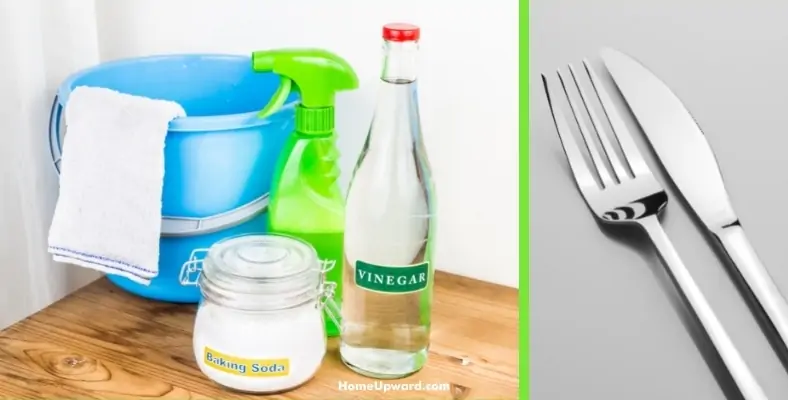Keeping your stainless steel pieces in peak condition can help ensure you maintain their value while keeping them ready for use over the forthcoming years. But many people don’t have a clear understanding of the environmental elements and cleaning mistakes that can impact their silverware.
To help guide you as you take on the cleaning process, I’ll share with you what you need to do to get the shine back into your stainless steel silverware at home.
Contents
How To Clean and Polish Stainless Steel Silverware
You can remove stains and improve the polished look of stainless steel silverware with household products.
Fill a bowl with half a cup of distilled white vinegar and two tablespoons of baking soda. You can then let the silverware soak in the mixture for two hours. After two hours, rinse your pieces with cold water and then polish them with a microfiber cloth.
How To Clean Tarnished Silverware
Tarnish can limit the aesthetic appeal of the piece. But finding cleaning strategies that don’t just remove the tarnish but also the top layer of the silver can be challenging.
Fortunately, there are a few options available to you. For example, you can combine warm water, baking soda, and aluminum foil to remove the tarnish.
Begin by boiling a larger pot of water. Then line the bottom of a large glass or plastic container with aluminum foil. Add your tarnished silverware to the container.
Once the water has reached a boil, add half a cup of baking soda to the water. Finally, pour the hot water and baking soda mixture over your tarnished silverware.
The reaction will cause the silver sulfide to return to its original silver state, and the sulfur atoms will attach to the aluminum. You’re then left with perfect silverware.
How Can I Make Flatware Shine?
When your flatware shines, it can impress guests to your upcoming events. And luckily, there are several simple methods to ensure flatware maintains its shine for the months ahead. First, you must create a cleaning solution.
Begin by combining dish soap and baking soda in a small bowl. Start with just a teaspoon of baking soda. Use the spoon to thoroughly mix the baking soda and the dish soap to create a consistent paste.
Then take an old toothbrush and mix the bristles into your paste. You can then use the bristles of the toothbrush on your flatware, one piece at a time, to remove stains.
This cleaning method is especially effective if you have burn marks on your flatware. Make sure that you scrub each piece gently and take your time with the process. Rubbing it with too harsh a material might remove the top layer of flatware.
What Causes Tarnish on Stainless Steel?
Despite the name, stainless steel can change color and degrade based on how you use it around the home. You may begin to notice that your once bright and beaming stainless silver now has a black, grey, or dulled coat across the metal surface.
Unlike metal rust, the stainless steel tarnish only affects the top layer of the material.
It’s an aesthetic issue rather than an issue that impacts the structure of the metal piece. Companies working with copper use the tarnish (patina) to create a certain aesthetic appeal for use around the home. In contrast, tarnish over the top layer of silver is a form of corrosion.
This corrosion is due to a chemical reaction the metal has with a nonmetal compound. Tarnish often results from stainless steel contact with elements such as oxygen and sulfur dioxide. The tarnish is usually, therefore, a metal-oxide material or metal sulfide.
How Do You Get Scratches Out of Silverware?
A scratch in an otherwise unblemished piece of silverware can detract from its value and cause you to consider removing the item from your home. But don’t throw away those old scratched silverware pieces just yet! There is a way to recover silverware and to get the scratches out of the silver surface.
Start by applying a small dab of toothpaste to the end of your finger. Then rub the toothpaste on the scratched area of the silverware carefully. Use a slow circular motion to rub the toothpaste into the item.
Continue the process until you cover all scratches with a thin layer of toothpaste. Finally, rinse the toothpaste off with warm water. Then pat the silverware dry with a soft cloth. You’ll see the shiny appeal of the original piece return.
How To Prevent Stainless Steel From Turning Black
You may find that your stainless steel turns black in the dishwasher. This can occur as a result of the detergent used in the machine.
The reaction between the material and the detergent causes stainless steel to turn black or dark blue. This reaction can also occur when using too harsh a cleaning product on stainless steel utensils or cookware.
You can prevent your stainless steel items from turning black by washing all of your items immediately after use. This washing process can help prevent food debris from wearing away the top layer of the steel. You might also consider drying your stainless steel items immediately to minimize water damage that might also result in black marks.
Another great way to prevent stainless steel from turning darker is to separate your pieces in the dishwasher. The compartments in the dishwasher are small, which causes stainless steel items to rub against one another, leading to damage over time.
Only wash a small number of items in your dishwasher in each cycle to minimize potential damage.
Use Lemon Juice To Remove Heat Stains
If you have dark heat stains on your stainless steel kitchenware, you might consider using lemon juice to remove the stain. Dab some lemon juice on a clean cloth. Then rub your stainless steel items in the lemon juice until the heat stain begins to fade. It’s an affordable method for recovering those high-value stainless steel kitchen products.






